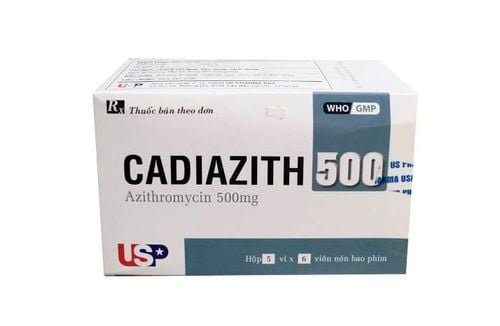This is an automatically translated article.
Azibiotic is a group of drugs that treat parasites, infections, viruses, and fungi. So what disease does Azibiotic treat, how does it work and how is it used at what dosage?1. What is Azibiotic?
Azibiotic has the main ingredient azithromycin, in the form of azithromycin dehydrate 500mg. The drug is prepared in the form of film-coated tablets with other excipients in full. The drug brings specific effects such as:
The azithromycin component of the drug Azibiotic is effective in cases of infections caused by bacteria sensitive to the drug such as: bronchitis, pneumonia, skin and soft tissue infections, otitis media. In addition, cases of upper respiratory tract infections including sinusitis, pharyngitis, and tonsillitis are also treated by Azibiotic Treatment effects with sexually transmitted infections for both men and women, especially treatment Treatment of uncomplicated genital tract infections caused by non-multiresistant Chlamydia trachomatis or Neisseria gonorrhoeae. In addition, Azibiotic is contraindicated in patients with hypersensitivity to the drug's components or to any antibiotic of the macrolide group. Patients with liver disease should also not use this drug in treatment because the drug is eliminated mainly through the liver.
2. Dosage and how to use Azibiotic
For adults and children over 12 years old use the starting dose of 1 tablet on the first day, the next 4 days take 1⁄2 tablets / day.
For children under 12 years old, use Azibiotic at a dose of 10mg/kg body weight per day for 3 consecutive days. Or you can use the dose of 10mg/kg on the first day, the next 4 days, take Azibiotic at a dose of 5mg/kg body weight.
Azibiotic should be taken whole and taken away from meals, at least 1 hour before meals or 2 hours after meals to achieve the best treatment effect.
If using too much Azibiotic, the patient will have typical symptoms such as hearing loss, nausea, vomiting, diarrhea. In this case, the patient should be treated at the nearest hospital facility, performing gastric lavage in combination with other effective supportive treatment measures.
3. Side effects when taking Azibiotic
Patients using Azibiotic drugs may experience common side effects such as nausea, abdominal pain, abdominal cramps, vomiting, flatulence, diarrhea. These conditions are usually mild and go away quickly. A small number of people will have manifestations such as rash, itching, fatigue, headache, change in the amount of liver enzymes ...
For women using Azibiotic drugs may experience side effects such as vaginitis, inflammation Cervical .
Some people who take high doses of Azibiotic for a long time may experience reversible hearing loss. With side effects, patients using the drug should not be subjective, if it is serious, they must immediately notify the treating doctor or go to a medical facility for advice and handling.
4. Azibiotic drug interactions
When using Azibiotic, it is necessary to know the interactions of this drug before and during use so that the therapeutic effect is maximized and there are no unfortunate consequences due to drug interactions. Specifically:
Patients should pay attention that Azibiotic should be taken 1 hour before meals or 2 hours after meals to ensure the pharmacological effect of the drug, because food can reduce the bioavailability of the drug by up to 50%. Do not use Azibiotic concurrently with ergot substances because of the high risk of toxicity. Note when using with antacids, need to take Azibiotic 1 hour before or after 2 hours. Carbamazepine: In pharmacokinetic studies in healthy subjects, no significant effect on plasma concentrations of carbamazepine or its metabolites was observed. It is recommended to take cimetidine 2 hours before Azibiotic so that the pharmacokinetics of Azibiotic are not affected. Some macrolide antibiotics interfere with the metabolism of cyclosporin, so patients using the drug need to be monitored for concentration and adjusted the dose of cyclosporin accordingly during the time of concomitant use of Azibiotic. Azibiotic may affect the metabolism of digoxin in the gut. When these two drugs are used concurrently, the patient should be monitored for increased digoxin levels. Should monitor theophylline concentration when using 2 drugs Azibiotic and theophylline for patients. Patients taking concomitant Azibiotic and Warfarin should be monitored for coagulation.
5. Notes when using Azibiotic
With possible side effects to users of Azibiotic drugs such as fatigue, headache, dizziness, drowsiness, patients need to be careful while driving or operating machinery.
Pregnant women or lactating women should consult a doctor before using the drug. Patients with liver failure should be cautious when using Azibiotic. Especially for patients with renal failure with ClCr < 40 mL/min, the dose should be adjusted appropriately and effectively as prescribed by the treating physician.
Hopefully with the above complete information about Azibiotic drugs, patients and treating doctors can use the drug effectively and safely.
Please dial HOTLINE for more information or register for an appointment HERE. Download MyVinmec app to make appointments faster and to manage your bookings easily.













